
Cotton is a soft, fluffy staple fiber that grows in a boll, or protective case, around the seeds of the cotton plants of the genus Gossypium in the mallow family Malvaceae. The fiber is almost pure cellulose, and can contain minor percentages of waxes, fats, pectins, and water. Under natural conditions, the cotton bolls will increase the dispersal of the seeds.

Gossypium is a genus of flowering plants in the tribe Gossypieae of the mallow family, Malvaceae, from which cotton is harvested. It is native to tropical and subtropical regions of the Old and New Worlds. There are about 50 Gossypium species, making it the largest genus in the tribe Gossypieae, and new species continue to be discovered. The name of the genus is derived from the Arabic word goz, which refers to a soft substance.

Malvoideae is a botanical name at the rank of subfamily, which includes in the minimum the genus Malva. It was first used by Burnett in 1835, but was not much used until recently, where, within the framework of the APG System, which unites the families Malvaceae, Bombacaceae, Sterculiaceae and Tiliaceae of the Cronquist system, the aggregate family Malvaceae is divided into 9 subfamilies, including Malvoideae. The Malvoideae of Kubitzki and Bayer includes 4 tribes:

Gracillariidae is an important family of insects in the order Lepidoptera and the principal family of leaf miners that includes several economic, horticultural or recently invasive pest species such as the horse-chestnut leaf miner, Cameraria ohridella.

Gossypium hirsutum, also known as upland cotton or Mexican cotton, is the most widely planted species of cotton in the world. Globally, about 90% of all cotton production is of cultivars derived from this species. In the United States, the world's largest exporter of cotton, it constitutes approximately 95% of all cotton production. It is native to Mexico, the West Indies, northern South America, Central America and possibly tropical Florida.
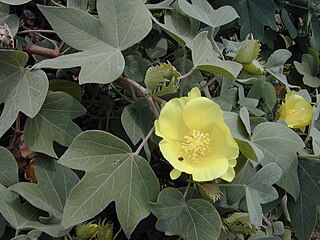
Gossypium tomentosum, commonly known as maʻo, huluhulu or Hawaiian cotton, is a species of cotton plant that is endemic to the Hawaiian Islands. It inhabits low shrublands at elevations from sea level to 120 m (390 ft). Maʻo is a shrub that reaches a height of 1.5–5 ft (0.46–1.52 m) and a diameter of 5–10 ft (1.5–3.0 m). The seed hairs (lint) are short and reddish brown, unsuitable for spinning or twisting into thread.
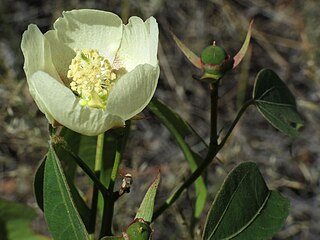
Gossypium thurberi, also known as Arizona wild cotton, Thurber's cotton, or desert cotton, is a wild species of cotton.

Gossypium australe is an endemic woody shrub, related to cotton, found in north western Australia. Preferring sandy soils near watercourses, it grows to about two or three feet tall. The leaves are grey and hairy, oval to elliptic, 3 inches (8 cm) long and soft to the touch. Flowers are around 1–2 inches (3–5 cm) long and present a pale pink mauve 'rose' with a deeper shade at the centre. Fruit are hairy, spherical and contain a bristly seed one-sixth inch (0.4 cm) long.

Gossypium arboreum, commonly called tree cotton, is a species of cotton native to India, Pakistan and Bangladesh and other tropical and subtropical regions of the Old World. There is evidence of its cultivation as long ago as the Harappan civilization of the Indus Valley for the production of cotton textiles. The shrub was included in Linnaeus's Species Plantarum published in 1753. The holotype was also supplied by him, which is now in the Linnean Herbarium in the Swedish Museum of Natural History.

Gossypium herbaceum, commonly known as Levant cotton, is a species of cotton native to the semi-arid regions of sub-Saharan Africa and Arabia, where it still grows perennially in the wild as a shrub.
Meloidogyne acronea, the African cotton root-knot nematode or African cotton root nematode, is a plant pathogenic nematode affecting pigeonpeas. It is also an invasive species. The roots and surrounding soils of cereals, grasses, and Gossypium spp. provide habitat for this organism. M. acronea was confirmed as a potentially problematic pest of cotton, Gossypium hirsutum cv. Makoka, which was proven through pot experiments.
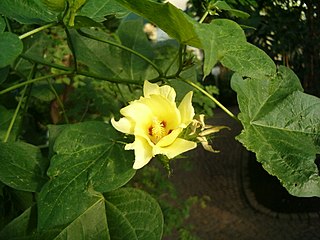
Gossypieae is a tribe of the flowering plant subfamily Malvoideae. It includes the cotton (Gossypium) and related plants. It is distinguished from the Hibisceae on the basis of embryo structure and its apparently unique possession of glands able to synthesize the pigment gossypol.

Earias perhuegeli, the rough bollworm, is a moth of the family Nolidae. The species was first described by Jeremy Daniel Holloway in 1977. It is found in the northern two-thirds of Australia and several islands in the South Pacific.
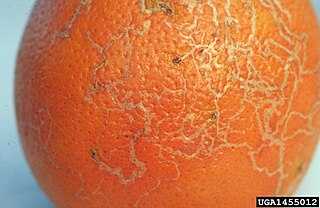
The citrus peelminer is a moth of the family Gracillariidae. It is known from California, Arizona, Texas and Florida in the United States and from Cuba.

Acrocercops bifasciata is a moth of the family Gracillariidae. It is known from Cameroon, the Democratic Republic of Congo, Malawi, Nigeria, Somalia, Sudan, Tanzania, Gambia, Uganda and India.
Phyllonorycter triarcha is a moth of the family Gracillariidae. It is known from India (Bihar), Indonesia (Moluccas), Malaysia, the Philippines and Thailand. This species is a well-known pest of cotton.
Acrocercops zygonoma, also known as a leafminer, is a moth of the family Gracillariidae, discovered in 1921 by Edward Meyrick. It is known from India (Bihar).
Acrocercops helicomitra is a moth of the family Gracillariidae, known from Brazil. It was described by Edward Meyrick in 1924. The hostplant for the species is Gossypium herbaceum.

Gracillariinae are a subfamily of moths which was described by Henry Tibbats Stainton in 1854.
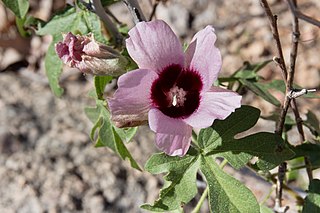
Gossypium anomalum is a species of wild cotton in the family Malvaceae, native to drier parts of Africa. A crop wild relative of cultivated cotton, its genome has been sequenced.














